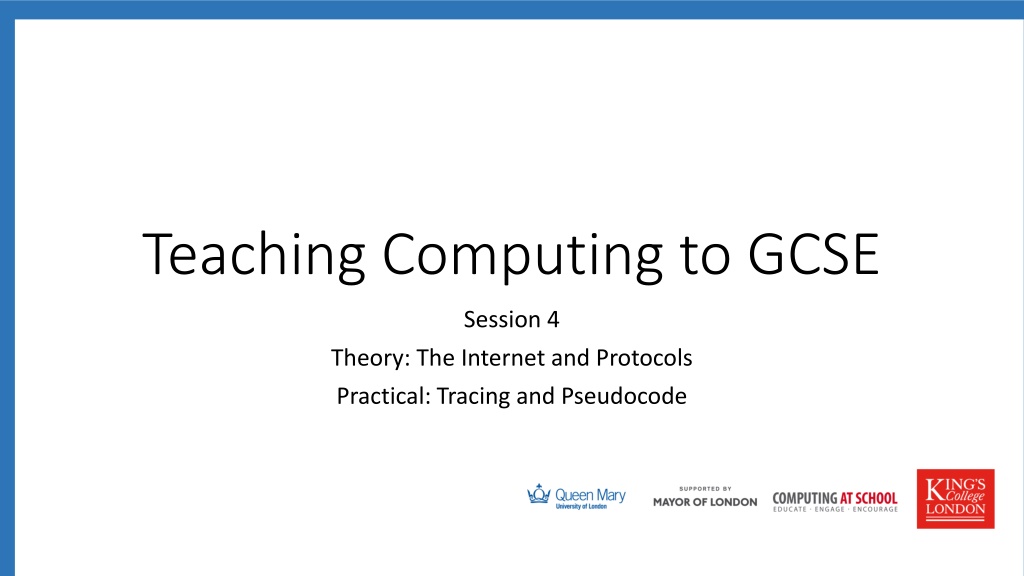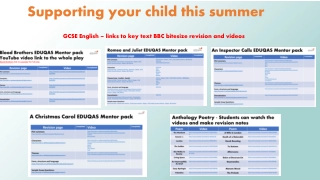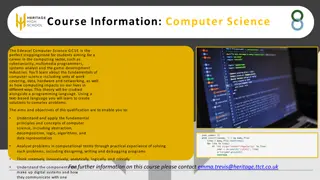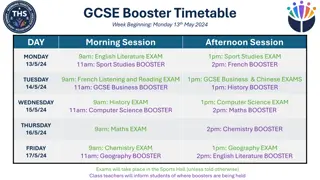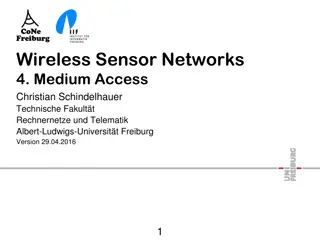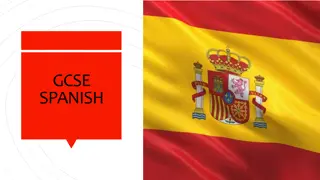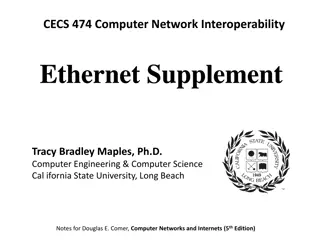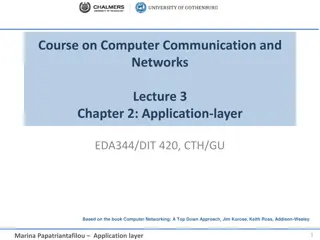Comprehensive Overview of Computer Networks and Protocols for GCSE Level
Explore the diverse aspects of computer networks and protocols through in-depth discussions on LAN, WAN, client-server relationships, hardware requirements, network topologies, protocols like TCP/IP and HTTP, and the significance of network layers. Understand the roles, benefits, and risks associated with different types of networks, wired and wireless connectivity, network speeds, and the principles of packet transmission and network topologies.
Download Presentation

Please find below an Image/Link to download the presentation.
The content on the website is provided AS IS for your information and personal use only. It may not be sold, licensed, or shared on other websites without obtaining consent from the author. Download presentation by click this link. If you encounter any issues during the download, it is possible that the publisher has removed the file from their server.
E N D
Presentation Transcript
Teaching Computing to GCSE Session 4 Theory: The Internet and Protocols Practical: Tracing and Pseudocode
Specification Content (1) OCR Types of networks: LAN, WAN Factors that affect the performance of networks The different roles of computers in a client-server and a peer-to-peer network The hardware needed to connect stand-alone computers into a LAN: wireless access points, routers/switches/NIC, transmission media The internet as a worldwide collection of computer networks: DNS, hosting, the cloud The concept of virtual networks Star and mesh topologies Wifi frequency and channels, encryption Ethernet The uses of IP addressing, MAC addressing, and protocols including TCP/IP, HTTP, HTTPS, FTP, POP, IMAP, SMTP The concept of layers Packet switching
Specification Content (2) AQA Define what a computer system is Discuss the benefits and risks of computer networks Describe the main types of computer network including: PAN, LAN, WAN Understand that networks can be wired or wireless Discuss the benefits and risks of wireless networks as opposed to wired networks Explain the following common network topologies: star, bus Define the term network protocol Explain the purpose and use of common network protocols including: Ethernet, Wi-Fi, TCP, UDP, IP, HTTP, HTTPS,FTP, SMTP, IMAP Describe the 4 layer TCP/IP model Understand that the HTTP, HTTPS, SMTP, IMAP and FTP protocols operate at the application layer. Understand that the TCP and UDP protocols operate at the transport layer. Understand that the IP protocol operates at the network layer.
Specification Content (3) Edexcel Understand why computers are connected in a network Understand the different types of networks (LAN, WAN) and usage models (client-server, peer-to-peer) Understand wired and wireless connectivity Understand that network data speeds are measured in bits per second (Mbps, Gbps) Understand the role and need for network protocols (Ethernet, Wi-Fi, TCP/IP, HTTP, HTTPS, FTP, POP3, SMTP, IMAP) Understand that data can be transmitted in packets using layered protocol stacks Understand the characteristic of network topologies (bus, ring, star, mesh).
Types of Network Computer networks are categorised according to their geographic coverage. Type of Network Description Example Wide Area Network (WAN) Connect computers over a large area such as a town, city or country. Company creating a private WAN to connect different parts of their business securely. Local Area Network (LAN) Connect computers over a building or a site. School network. Personal Area Network (PAN) Connect the computers or devices used by one person. Bluetooth headset connected to a mobile phone.
Example LAN A wireless access point is used to enable devices to connect to a LAN wirelessly. Routers are used to connect a LAN to another network, for example the Internet. The Internet A switch is used to connect the devices in a LAN together. wireless access point are often combined into one device called a wireless router. In homes the switch, router and Each device needs a network interface card (NIC) to connect to a LAN. Most devices have these built in.
Transmission Media There are three main types of media that are used to connect computers together in a network. Copper Cable Fibre Optic Cable Wireless
Peer-to-Peer and Client-Server Models Networks can also be categorised by the role computers play in them. Peer-to-Peer Client-Server The simplest type of network, each computer is equal. Computers share information and resources with each other. One central computer called a server shares files and resources with the other on the network computers known as clients.
Topologies The term topology refers to the way in which devices are connected in a network. The table below summarises the different network topologies. Topology Description Bus Single main cable to which computers are connected. Ring All computers are connected in a circle. Star All computers have their own link to a central computer. Mesh Where each computer can connect to multiple computers.
Activity 1 This activity will demonstrate a fun way of teaching topologies.
Activity 2 This table is designed to summarise the advantages and disadvantages of each topology. Use the text in the notes section to complete it. Topology Advantages Disadvantages Bus Ring Star Mesh
Network Addressing Like a house, every device on a network needs a unique address to ensure that data reaches the correct destination. A MAC address is a unique number written into the network card, appears as six pairs of hexadecimal characters. 00:10:5A:44:12:B5 Each device connected to a network is also assigned an IP address. Unlike a MAC address, an IP address is not pre-set and can be changed.
The Internet and the WWW The Internet is a vast collection of interconnected networks spread across the world. The World Wide Web is a huge collection of webpages stored on web servers that can be accessed through the Internet. The act of a web server making webpages available via the Internet is known as hosting.
DNS The Domain Name System (DNS) is designed to match up a user-friendly domain name like facebook.com to an IP address. A device can send a request to the DNS server for an address and the DNS server will reply with an IP address. The device can then use this IP address as their destination.
Activity 3 The table below should show a list of IP addresses and corresponding domain names. You need to complete it, use http://ipinfo.info/html/ip_checker.php to help you. IP Address Domain Name 172.217.25.228 31.13.74.36 www.kcl.ac.uk www.qmul.ac.uk
Ethernet Ethernet is a group of networking technologies that are used in most wired networks such as LANs and WANs. Transmission media used in Ethernet networks include copper and fibre- optic cables.
WiFi WiFi or Wireless Fidelity is the technology used in wireless networks. WiFi uses radio waves to transmit information. The frequency ranges 2.4 GHz and 5 GHz are reserved for WiFi to avoid interference with devices that use different wireless technologies. Each frequency range is split into a set of channels. WiFi networks that are near to each other should operate on different channels in order to avoid interference.
Packet Switching In modern networks data is split into chunks called packets before they are sent. Each packet is sent separately and will follow the best route at that time, this means packets may take different routes. This process is known as packet switching.
Protocol Description Activity 4 TCP A protocol is a set of rules that devices on a network follow in order to communicate. Complete this table using the text in the notes section of the slide. IP UDP HTTP HTTPS FTP POP3 IMAP SMTP
TCP/IP Model Network functionality is often split into layers to make it easier to understand. The TCP/IP model is made up of four layers, packets travel through them when sent and received. The HTTP, HTTPS, SMTP, IMAP and FTP protocols operate at this layer. Application Layer Application Layer Transport Layer Transport Layer The TCP and UDP protocols operate at this layer. Internet Layer Internet Layer The IP protocol operates at this layer. Network Layer Network Layer Transmission Media
The Cloud More and more services such as data storage and applications are being moved into the cloud. The cloud is simply a set of data centres around the world that offer services that can be accessed via the Internet and a web browser. These services can be accessed using any computer connected to the Internet.
Virtual Networks There are two main types of virtual network: Type Description Example VLAN (Virtual Local Area Network) Uses software to divide a physical LAN into smaller networks. A company wanting each department to operate on a separate network. Uses existing infrastructure and encryption to create a virtual link between separate physical networks. A company with offices in multiple countries want to link their networks together via the Internet. VPN (Virtual Private Network)
Break After the break we will look at tracing and pseudocode.
